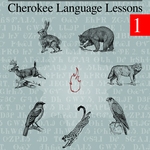
Pronunciation
Vowel Sounds
Cherokee has six main vowels. They are “a”, “e”, “i”, “o”, “u”, and “v”.
They are generally pronounced as follows:
-
a: as (a) in father.
-
e: as (a) in cake. Some speakers shift this letter to sound more like the “e” in “echo”.
-
i: as (e) in Pete. Some speakers shift this letter to sound more like the “i” in “pit”.
-
o: as (o) in hello.
-
u: as (u) in tuba.
-
v: as (u) in rung and is always nasalized (sounded through the nose).